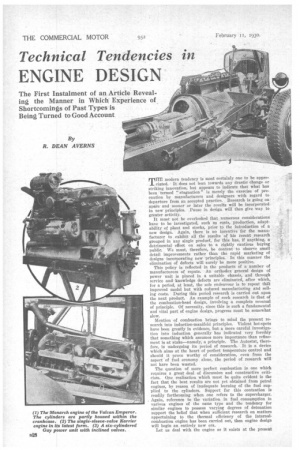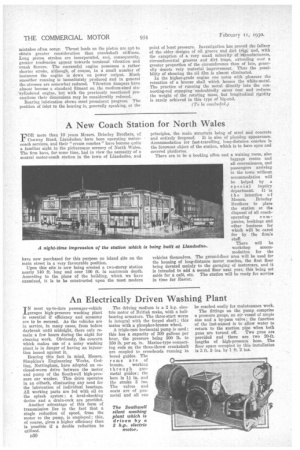Technical Tendencies in
Page 106

Page 107

Page 108

If you've noticed an error in this article please click here to report it so we can fix it.
ENGINE DESIGN
The First Instalment of an Article Revealing the Manner in Which Experience of Shortcomings of Past Types is
Being Turned to Good Account
T'
, modern tendency is most certainly one to be appre ciated. it does not lean towards any drastic change or striking innovation, but appears to indicate that what has been termed " stagnation " is merely the exercise of precaution by manufacturers and designers with regard to departure from an accepted practice. Research is going on apace and sooner or later the results -will be incorporated• in new principles. Pause in design will then give way to greater activity.
It must not be overlooked that numerous considerations have to be investigated, such as costs, production, adaptability of plant and stocks, prior to the introduction of a new design. Again, there is no incentive for the manufacturer to exhibit all the results of his recent research grouped in any single product, for this has, if anything, a detrimental effect on sales to a rightly cautious buying public. We must, therefore, be content to observe small detail improvements rather than the rapid marketing of designs incorporating new principles. In this manner the elimination of defects will surely be more positive.
This policy is reflected in the products of a number of manufacturers of repute. An orthodox general design of power unit is placed in a suitable chassis, and through service and knowledge defects are eliminated, after which, for a period, at least, the sole endeavour is to repeat tint improved model but with reduced manufacturing and selling costs. During this period research is carried out upon the next product. An example of such research is that of the combustion-head design, involving a complete reversal of principle. Of necessity, since this is such a fundamental and vital part of engine design, progress must be somewhat slow.
Mention of combustion brings to mind the present research into induction-manifold principles. Violent hot-spots have been greatly in evidence, but a more careful investigation into induction generally has indicated very forcibly that something which assumes more importance than refinement is at stake—namely, a principle. The Autostat, therefore, is undergoing its period of research. It is a device which aims at the heart of perfect temperature control and should it prove worthy of consideration, even from the aspect of fuel economy alone, the period of research will not have been wasted.
The question of more perfect combustion is one which requires a great deal of discussion and constructive criticism. One realization which must be quite evident is the fact that the best results are not yet obtained from petrol engines, by reason of inadequate burning of the fuel supplied to the cylinders. Support for this contention is readily forthcoming when one refers to the supercharger. Again, reference to the variation in fuel consumption in various engines of the same type and the tendency for similar engines to possess varying degrees of detonation support the belief that when sufficient research on matters appertaining to the thermal efficiency of the internalcombustion engine has been carried out, then engine design will begin an entirely new era.
Let us deal with the engine as it exists at the present
period. The adoption of cylinder liners, in either a nitralloid steel or centrifugally cast iron, is an innovation which will be appreciated by the operator. Naturally, it is regarded as a means for reduction in maintenancecost s, an d whilst it is open to discussion whether barrel wear is decreased thereby, this should be considered as a temporary expedient only. Investigations should lie in the production of a cylinder material which resists what is termed—in all probability erroneously — cylinder " wear."
The introduction of nickel into the material has proved, in many cases, most beneficial in more aspects than the reduction of wear. From experiments the writer carried out recently the question as to whether wear actually does take place to such a degree as is commonly supposed, is very debatable. Examination of the factors involved leads
one to the conclusion that the increase In diameter is due to the crushing of the surface material of the bore and the closing up of the grain, in combination with the effect of the lubricant on the piston and cylinder walls. It is, of course, rather in support of this contention that the rate of wear in the cylinder bore decreases as the walls become of larger diameter.
Development of materials suitable for use in components which are subject to very high temperatures has brought the aluminium-alloy piston rapidly to the fore. The inclusion of the aluminium piston in a specification does not necessarily mean that it possesses the advantages of better heat conductivity with the consequent reduction of carbon deposit under the piston head ; it does, of course, reduce the reciprocating weight.
A properly designed cast-iron piston still retains many advantages. Piston expansion is receiving attention, and in the near future the results of investigation will be known. However, "rough" engines are rapidly becoming scarce, and this is in some measure due to the combination of improvements in cylinder-head design, induction-manifold modifications and piston research. This feature alone has done much to relieve the engine of many stresses which had become almost uncontrolled and well-nigh incapable of being calculated, The insistent demand for high average road speeds has been responsible for the general improved standard of detail design. More robust—but not necessarily heavier—engines have resulted. The use of higher grade material and improved heat treatment in many cases, have been all that was necessary to enable reasonable stresses to be absorbed. Dimensional increases naturally entail more considered design when weight is such an important factor.
Thus we find the recently accepted 40-ton carbon-steel crankshaft, with comparatively small-diameter bearings, superseded by 5560ton nickel-chromium steel, heat-treated. The big-end and main bearings are much larger in diameter, but usually the crankpins are eccentrically drilled, thus reducing the rotating mass. Many other advantages are attached to such an advisable development. The erankwebs automatically become stiffer and the whole shaft is capable of maintaining higher rotational speeds. Occasionally, by considered design, it is found possible to revert to the fourbearing crankshaft, which now has definitely regained favour amongst designers of modern, high-speed, six-cylindered engines.
One of the main considerations, however, is an endeavour to reduce overall dimensions. At this junction serious D29 mistakes often occur. Thrust loads on the piston are apt to obtain greater consideration than crankshaft stiffness. Long piston strokes are incorporated, and, consequently, greater tendencies appear towards torsional vibration and crank flexure. The successful engine possesses a rather shorter stroke, although, of course, in a small number of instances the engine is down on power output. Much smoother running is immediately produced and in general the stresses are somewhat reduced. Vibration dampers have almost become a standard fitment on the medium-sized six-cylindered engine, but with the previously mentioned precautions their dimensions may be considerably reduced.
Bearing lubrication shows most prominent progress. The position of inlet to the bearing is, generally speaking, at the point of least pressure. Investigation has proved the fallacy of the older designs of oil groove and dirt blip, and, with the exception of a very small minority of Manufacturers, circumferential grooves and dirt traps, extending over a greater proportion of the circumference than of late, generally denote very material improvement. Thus the possibility of shearing the oil film is almost eliminated.
In the higher-grade engine one notes with pleasure the retention of a bronze shell which houses the white-metal. The practice of running the metal directly into the connecting-rod stamping undoubtedly saves Cost and reduces the weight of the rotating mass, but longitudinal rigidity is rarely achieved in this type of big-end.
(To be concluded.)




























































































































































































































